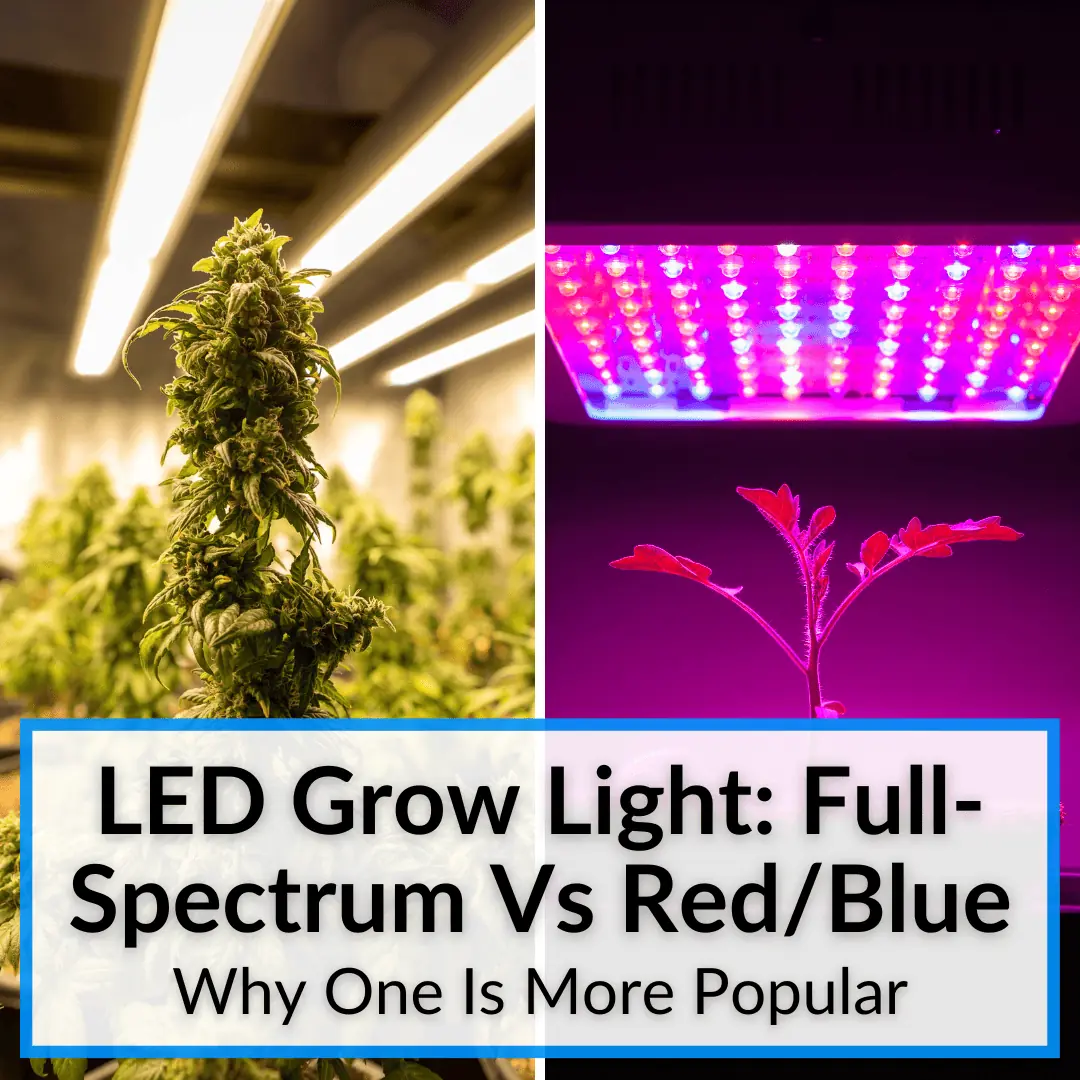 Do you remember 5 to 10 years ago?
Do you remember 5 to 10 years ago?
Back then LED grow lights were just starting to take over.
Most used a red/blue spectrum that made our grow rooms glow pinkish-purple.
These days, those “blurple” lights have fallen out of favor.
When it comes to this years-long battle of types of LED grow light, full spectrum vs red-blue has ended up with a clear winner.
Why is that? Why does full spectrum white light dominate the market these days?
Keep reading to find out. You’ll see that full-spectrum white light makes more sense for most uses, but there are still situations where a blurple light makes sense, too.
Contents
- 1 LED Grow Light Full-Spectrum Vs Red/Blue
- 1.1 Full-Spectrum LED Grow Lights
- 1.2 Red/Blue LED Grow Lights
- 1.3 Similarities Between Blurple And Full Spectrum LED Lights
- 1.4 Differences Between Red/Blue Vs Full Spectrum LED Grow Lights
- 1.5 Advantages Of Full-Spectrum LED Grow Lights
- 1.6 Advantages Of Red/Blue LED Grow Lights
- 1.7 Reasons To Get Full-Spectrum LED Grow Lights
- 1.8 Reasons To Get Red/Blue LED Grow Lights
- 2 Red-Blue Vs Full Spectrum LED Grow Lights: Final Thoughts
LED Grow Light Full-Spectrum Vs Red/Blue
We will begin our comparison of red-blue LED grow lights vs full spectrum ones by looking at each type of LED light individually, before comparing the two directly. We will go over the advantages of each and then explain when it makes sense to get each type.
Full-Spectrum LED Grow Lights
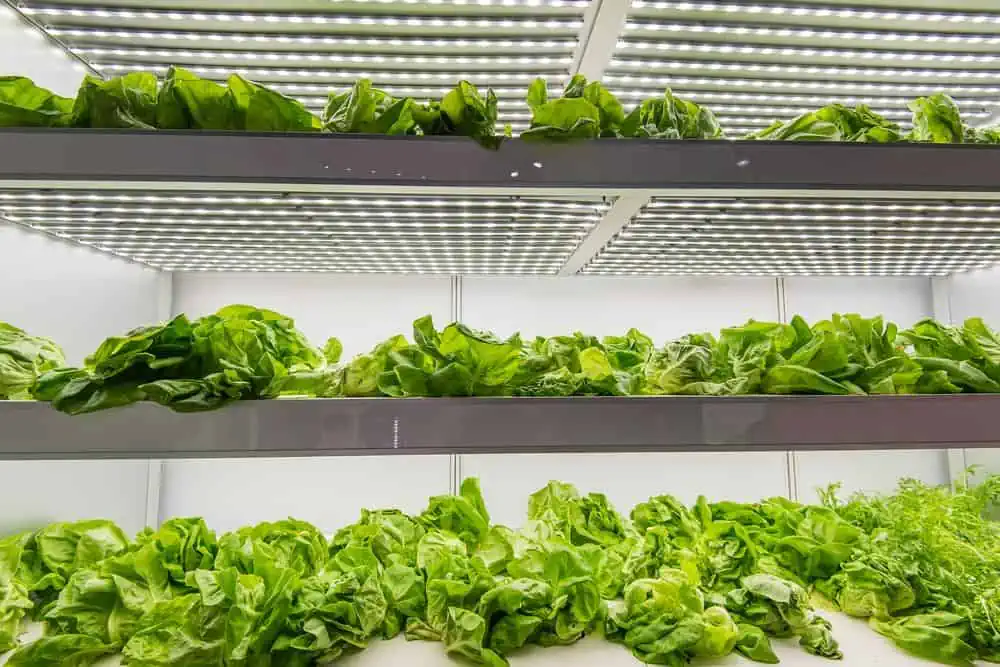
The range of light wavelengths which are most beneficial to plants lies between 400 and 700 nanometers, which is commonly referred to as the ‘PAR,’ or ‘photosynthetically active radiation.’
All light that falls within this spectrum will be helpful to your plants, but some wavelengths in this range are more beneficial than others. The wavelengths of light that encourage plant growth the most are the blue and red wavelengths.
The red and the blue segments of the light spectrum are, therefore, the most important in aiding a plant’s growth. Blue light stimulates the formation of chlorophyll and red light promotes seed germination, healthy root growth, and flower development.
A full-spectrum LED grow light will provide these wavelengths, as well as everything in between. This results in a user-friendly white light that is similar to natural daylight. It is ideal for cannabis plants,or any other type of plant.
Red/Blue LED Grow Lights

Rather than emitting a full spectrum of light, a red/blue LED grow light emits a more targeted range of light. These fixtures focus on producing the most beneficial ranges of wavelengths only—the red and the blue wavelengths—with the ranges in between absent.
The light emitted by red and blue LED grow lights is perceived as a purple-red light, which is often referred to as “blurple” light. It is great for your marijuana plants, but somewhat irritating to human eyes.
Similarities Between Blurple And Full Spectrum LED Lights
The most important similarity is the fact that both full-spectrum and red/blue LED grow lights are capable of bathing your budding weed plants in both the red and blue wavelengths of light. In simple terms, this means that both types of LED grow lights can help you improve the health of your plants and increase your yield come harvest time.
Differences Between Red/Blue Vs Full Spectrum LED Grow Lights
While they both produce the red and blue wavelengths of light, only full-spectrum LED grow lights produce the in-between wavelengths, at least to a significant degree.
The in-between wavelengths, which are present in natural daylight, are also beneficial to your plants, but not as much as the red and blue wavelengths. Using a LED grow lights spectrum that is full will, to a certain degree, provide your plants with more beneficial light rays.
However, plants do not absorb those middle wavelengths of light as well as the red and blue wavelengths. That means that much of this energy goes to waste. These wavelengths of light simply bounce off the surface of your plants.
The wasted energy, aside from costing you money directly on your energy bills, also produces heat that you need to deal with, costing you a little bit more in the running costs of your cooling equipment.
Some people prefer red/blue LED grow lights for these money-saving reasons. But for the most part, the industry has switched away from blurple lights, in favor of full-spectrum white lights.
We now know that wavelengths other than red and blue do help plants, even if the plants do not use nearly as much of that light. Sure, it might cost a little more to power all-white lights (meaning some of the light you pay for is not used), but the addition of the other wavelengths more than makes up for it overall.
Advantages Of Full-Spectrum LED Grow Lights
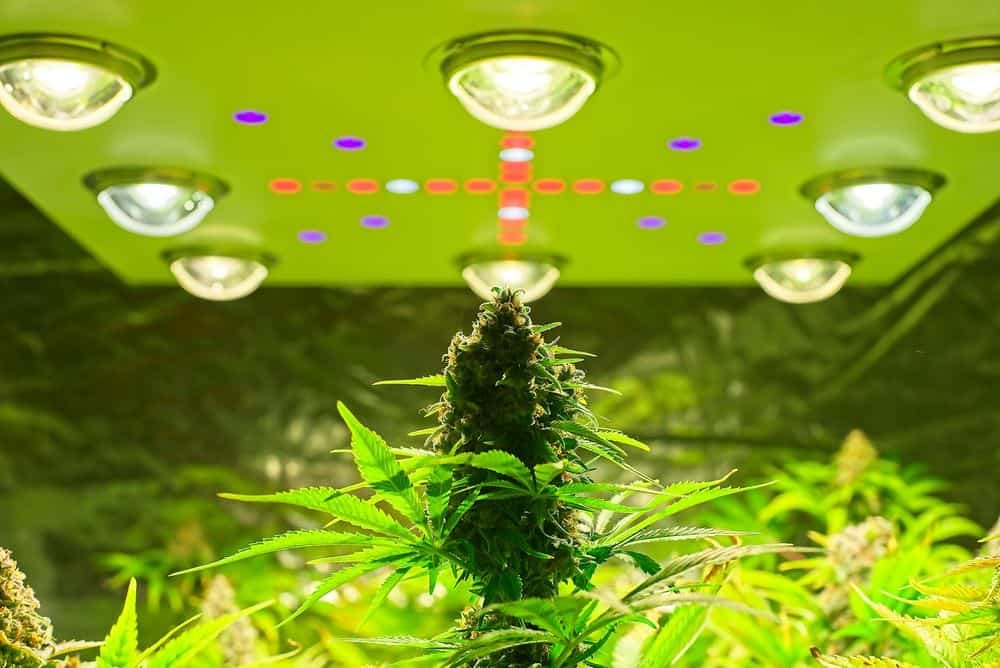
As mentioned, the main difference between the two types of LED grow lights is in the spectrum, and that is where all of the advantages of a full spectrum light come from.
Lower Initial Outlay
Because white light has more applications outside of cannabis cultivation, the technology is more widely available. With more companies producing full-spectrum LEDs, the market is more competitive, which has resulted in prices being driven down over time.
You can also buy regular LED lights instead of dedicated grow lights, since those all emit white light. This may not be the best idea, unless you simply don’t have the budget. Learn all about using standard LED lights vs LED grow lights.
Full Spectrum Includes The Middle Wavelengths
While it’s undeniable that the most beneficial wavelengths for your plants are the red and blue wavelengths, the middle wavelengths are also beneficial, just to a lesser degree. Full-spectrum LED grow lights also provide these middle wavelengths, so your plants receive more beneficial light overall.
Akin To Natural Daylight
The white light emitted by full-spectrum LED grow lights is much more similar to natural daylight from the sun than the light emitted by red/blue LED grow lights. Not only is this white light less irritating to our eyes, but, perhaps unsurprisingly, it also allows you to see better and monitor your plants health more easily.
With a red/blue grow light, your plants will appear very different, and you may have trouble spotting any early tell-tale signs of any health issues that you would spot very quickly under natural or white light.
Advantages Of Red/Blue LED Grow Lights
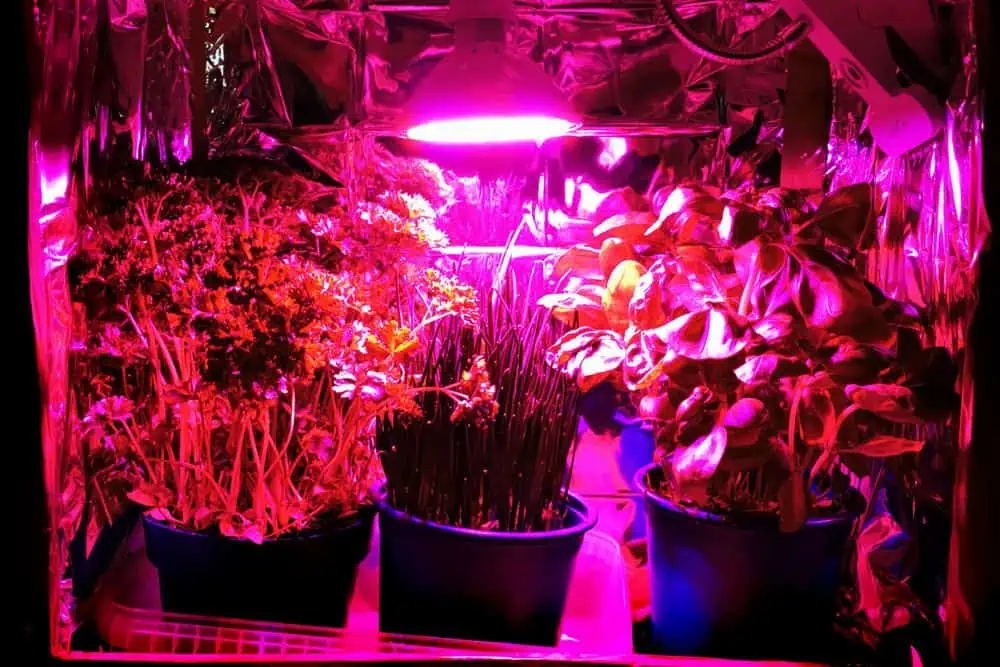
The main advantages of blurple LED grow lights have to do with more of the light they admit being used by plants. And certain plants, like aquatic ones and ones that don’t flower, use blue light much more than red. Can LED lights grow aquarium plants? Yes, they can. They are ideal for the purpose.
More Energy Efficient
LED lights that solely emit targeted red and blue wavelengths of light are more energy efficient than full-spectrum LED grow lights. LED grow lights are the most efficient type of grow light on the market, and the blurple ones are the most energy-efficient LED grow lights.
Full-spectrum grow lights use energy to produce the mid-range wavelengths too, and much of this is then wasted. You plants will not absorb it all. It simply reflects off the surface of your plants and up into your grow space.
Produce Less Heat
Because your plants absorb a higher percentage of the emitted light, less of that light energy gets wasted, and less heat is produced. Less heat means that you will need less energy to keep your grow space cool, and you can save a little extra on your energy bills as a result.
Can Be Used In Conjunction With Other Grow Lights
Depending on your budget and the size of your cannabis growing operation, you may want to investigate the pros and cons of using red/blue LED grow lights as a supplement to other light sources.
Some more-experienced growers like to use a full-spectrum grow light overhead and red or blue LED grow lights as sidelights, to give their plants an extra boost during the flowering and vegetative stages respectively.
Reasons To Get Full-Spectrum LED Grow Lights
Full-spectrum LED grow lights are the best option for growing plants. While it is true that some light is wasted, we now know that white light is better for growing.
Once your growing skills start to improve, you can then consider adding red/blue LED lights to the side of your grow space, which will give a more even light to your entire crop, and boost your yields even further.
But as your primary light source, white light is simply the better option. It is no coincidence that all of the top grow LED lights on the market today emit a full-spectrum white light, not a blurple light.
Reasons To Get Red/Blue LED Grow Lights
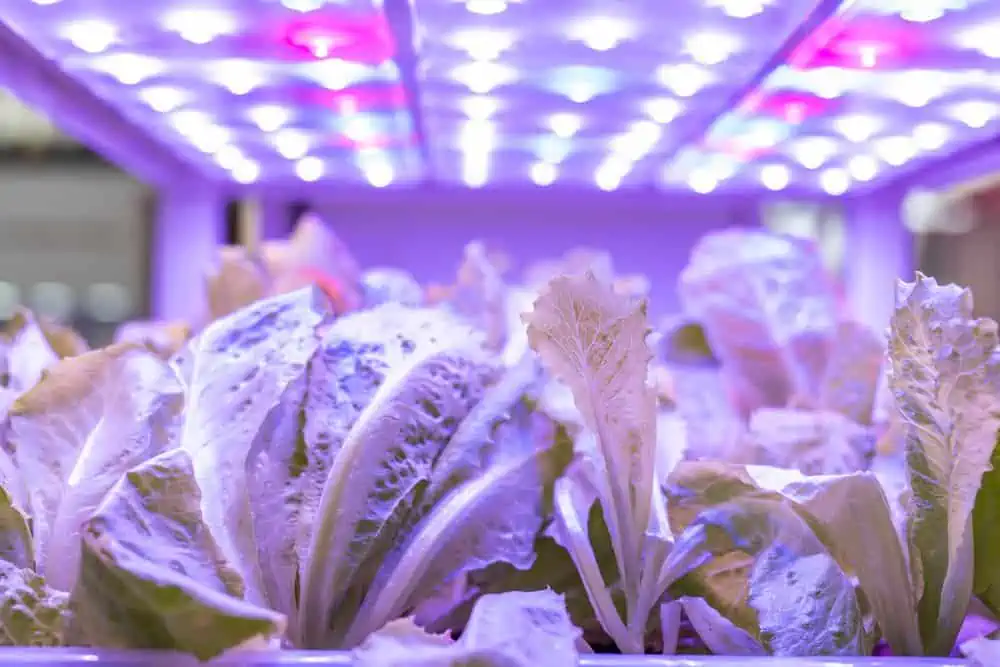
The only reason to get blurple lights these days is if you believe that the improved absorption rate of the wavelengths the light emits is more important than giving your plant light in every wavelength.
As mentioned, the industry as a whole has moved away from this thinking and now primarily used all-white LED grow lights. HLG was the pioneer in all-white lights and they are still the industry leader. Spider Farmer is the best budget brand.
Red and blue LED grow lights still make a lot of sense if you use them as supplemental light, in additional to primary fixtures that emit full-spectrum white light. In fact, many of the most popular full spectrum fixtures actually include additional red (and sometimes blue) diodes right on the fixture itself.
Red-Blue Vs Full Spectrum LED Grow Lights: Final Thoughts
Most growers use full spectrum LED grow lights these days, but the red-blue fixtures are actually more efficient. They waste less light and generate less heat as a result.
Does that mean you should use one? Not as your primary light source. When it comes to LED grow lights, full spectrum vs red-blue is not a close fight.
We now know that plants use light in all wavelengths and grow stronger and yield more and higher quality buds when they get all wavelengths. Plus, your eyes will thank you!
Kelly Kho says
Please disregard my application for the course on growing cannabis
Steven says
If you’ve signed up and don’t want to be signed up, click on the unsubscribe link at the bottom of any email you receive.
Drew Pike says
I am growing houseplants that are not cannabis. They were cuts we stuck in water to root and have grown a couple inches in a couple weeks. I bought a cheap grow light that is red blue and blurple. I am wondering for the first 6 months should I run the red blue or purple lights? Should I use a mix? I get 3 hours of afternoon filtered light is that enough and not use the grow light at all? I am just getting into growing plants and am trying to propagate plants from family and friends. I hope to get good enough I can do the harder plants and more expensive plants. Is there a book you would recommend to get me started? Thanks for any info and help you can give me.